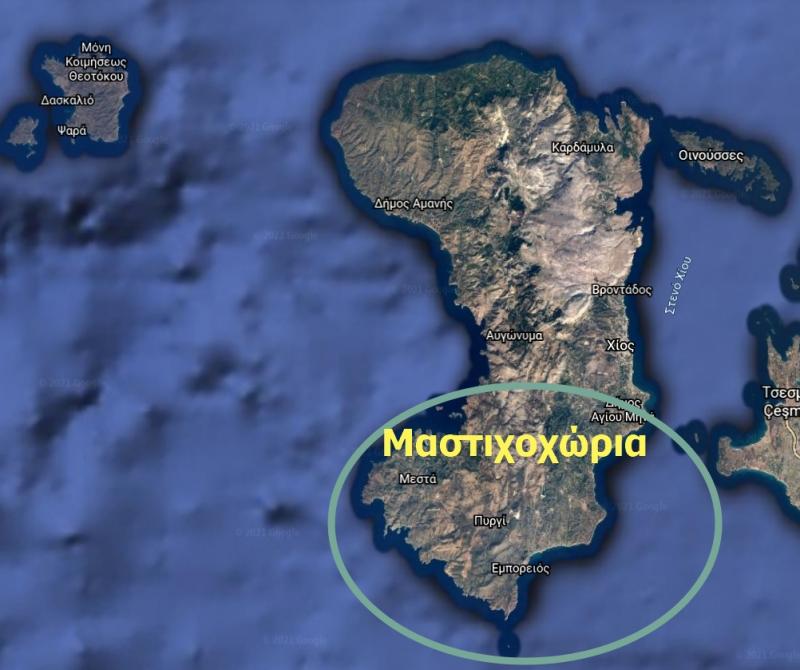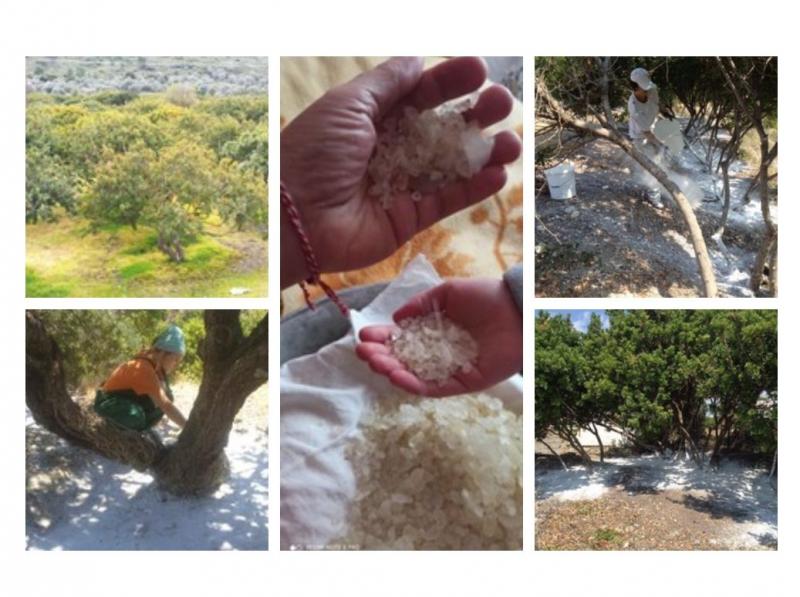Author: 2nd Grade Lower Secondary, Volissos High School, GR
PARTNERS: 2nd Grade Lower Secondary, Olympion High School, CY;
1st Grade Upper Secondary, SS Vela Luka, HR
Introduction

Chios- Mastic village
In the northeastern Aegean, on the crossroads from East and to West, on the island of Chios, mastic grows since centuries; mastic a product - a treasure whose unique beneficial and healing properties are scientifically proven.
Chios mastic (Pistacia Lentiscus var. Chia) is the resinous secretion of the mastic tree (Pistacia Lentiscus var. Chia). It is a natural, aromatic resin, which is secreted in the shape of tears from the trunk and large branches of the mastic tree, from the surface incisions caused by the producers’ sharp tools.
In 2014, mastic cultivation was inscribed on the list of the intangible cultural heritage of mankind (UNESCO 2003).
The mastic tree or schinos - scientifically Pistacia Lentiscus var. Chia (family Anacardaceae), is an evergreen dense bush 2-3 meters tall, which grows slowly and gets its full growth after 40-50 years, reaching up to 5 meters tall in older plants. The schinoi are the main element of the Macchia plantation of the Mediterranean countries, but only in the Southern Part of Chios, in Mastichochora, the special characteristics of the soil and the microclimate, and the traditional cultivation finally bring such an impressive result and shape the uniqueness of this special resin. Any attempt to expand the crop beyond this limit has failed.
Nowadays, the results of laboratory and clinical research conducted by independent researchers in Greece and abroad, alike, prove that natural Chios mastic has unique beneficial and therapeutic properties; thus they confirm relevant historical references. In particular, the beneficial effect of mastic on diseases of the digestive system, its contribution to oral hygiene, its significant antimicrobial and anti-inflammatory action and the fact that it is a natural antioxidant has been scientifically proven.
Additionally, Chios mastic contributes to the healing of wounds and the regeneration of the skin. Also, Chios mastic is used in cooking and confectionery, distillery and cosmetology.
Learning Objectives
- To know what Chios mastic is and where it is cultivated
- To know the characteristics of mastic
- To distinguish the stages of cultivation of the mastic tree
- To know which are the mastic villages of Chios
- To know the uses and benefits of mastic in medicine, in the distillery, in cosmetology and in cooking-confectionery
- To know cooking recipes and confectionery with Chios mastic
Task

Mastic tree cultivation
In this particular SeedQuest students will know that Chios Mastic is a unique product worldwide; they also will know its uses in many sectors of human activity (medicine, pharmaceuticals, cosmetology, cooking, confectionery, distillery).
At the end of the program students will be able to understand the properties, the benefits and the uses of mastic. They will know the place, the way and the stages of cultivation of the mastic tree. Thus, they will know the special element of the biodiversity of Chios.
Process
ACTIVITIES
Activity1: Brainstorming - Padlet
The students are informed about the topic they will study. Initially, they are given a blank internet board (padlet) on which they will record what they know about Chios mastic. The brainstorming technique does not require students to have specific knowledge of the subject matter and it allows each student to express himself / herself on the subject, recalling pre-existing knowledge and perceptions about it, without being evaluated.
Activity 2: Study material - View videos - Create groups

Then, they are given a list of links related to the cultivation and utilization of mastic. After studying the material and watching two videos suggested by the teacher, the children are divided into three groups to carry out parallel activities.
The list of links and videos is uploaded on the padlet.
Create groups - Group names:
- Group 1: Mastic trees
- Group 2: Mastic taste
- Group 3: Tears of Chios
Activity 3: Using the material of Activity 2, use Google Docs and create a presentation on the properties and uses of mastic (Group 1).

Activity 4: Using the material of Activity 2, use Google Docs and create a presentation with Chios mastic recipes, suitable for children (Group 2).
Activity 5: Using the material of Activity 2, use the online tool PosterMyWall and create a poster with the theme "Chios Mastic - Cultivation & Uses" (Group 3).
Activity 6: Using the material of Activity2, use the online tool Maphub to create an interactive map on which to place the mastic villages of Chios (pins) (Group 3).
Activity 7: Presentation of the group work in the classroom.
Discussion, comments and remarks on the works.
Activity 8: With the support of your teachers, execute a recipe with Chios mastic as the main ingredient. You can choose one of the recipes you recorded in a previous activity and create videos with that recipe.
Activity 9: Interview a mastic producer. Create informative videos with the support of your teachers.
Activity 10: Visit some of the mastic villages and watch an informative presentation by the president of the Chios Mastic Producers Association.
Activity to capture the feelings of the participant students.
Write down three emotions that your participation in the program caused you.
(menti.com Κωδικός: 5822 5709)
Extra game:
My Puzzles - Green Seeds - Chios Mastic - Green seeds mastic trees (jigsawplanet.com)
Make the Puzzle.
Mastic trees Puzzle

Potential Activity for all groups:
Under normal circumstances (non-pandemic) an additional activity would be the visit of the students to the Mastic Museum.
Evaluation - Quizzes
https://learningapps.org/18669039
Learning app

And the game goes on….
Kahoot! Quiz
https://kahoot.it/challenge/09879860?challenge-id=4604f138-af97-43ef-8b7c-ee7cef9b1c57_1617312049500

Evaluation
- To know what Chios mastic is and where it is cultivated.
- To know the characteristics of mastic.
- Το distinguish the stages of cultivation of the mastic tree.
- To know which are the mastic villages of Chios.
- To know the uses and benefits of mastic in medicine, in the distillery, in cosmetology and in cooking.
- Τo know the mastic trees.
- To discover information related to Chios mastic.
- To present the benefits and uses of mastic in various sectors of our lives.
- To develop their observation, their imagination and their critical thinking.
- To collaborate and cultivate their social skills.
- To evaluate the taste of mastic.
- To acquire communication skills.
It is important our students to evaluate the knowledge acquired through their participation in the program. For this reason, we created two assessment quizzes based on the principles of playful learning.
Because the students participated in such a program for the first time, we considered that it would be useful to record the emotions they expressed during their participation in the program (such as satisfaction, confidence, enthusiasm).
In general, we consider it important to underline the impact of their participation in the Program on students and teachers, alike.
Evaluation of the Presentations
The PowerPoint presentation will be evaluated as follows:
Checklist
|
Creativity / Content (images, scientific names, information and description) Answer every question asked in the pronunciation. |
|
|
Grammar (spelling, punctuation, sentences) |
|
|
Consistency / clarity (each slide should have the same font and design. The presentation looks professional) |
Poster Evaluation Rubric
|
Evaluation Rubric |
Very good |
Good |
Needs improvement |
|
Content Printed in lists, charts, graphics, text |
It includes all the stages of cultivation of the mastic tree It includes three or more mastic graphics All information is accurate |
It includes three stages of cultivation of the mastic tree Includes two graphic images related to mastic One of the displayed information is inaccurate |
It includes two or more stages of cultivation of the mastic tree It iIncludes one or no graphic-related images related to mastic Includes more inaccurate information |
|
Spelling & text size – objects
|
It has no spelling mistakes Text is legible - Font size is correct |
2-3 spelling mistakes Some information is not legible |
More than three spelling mistakes The data is so small that it cannot be read |
|
Poster design
objects-colors |
Properly placed items directly convey the meaning of the information Color contrasts Colored background |
1-2 incorrectly placed objects do not directly convey the meaning of the information Few color contrasts Monotone background |
3 or more incorrectly placed objects that do not directly convey the meaning of the information No color contrasts Without background |
Conclusion
You have now reached the end of our web exploration!
Let's return to it for a while and explore the treasure of the Chian land, the Chios Mastiha!
You read about the history of Chios Mastic. You got to know the Mastic Tree and the mastic villages, you distinguished the stages of cultivation of schinos, you studied the properties and benefits of mastic in areas of our life such as medicine, pharmacy, cooking, confectionery, etc.
And all this by utilizing the internet and the Web 2 tools, alike, which were essentially utilized in the learning process; thus they contribute to the development of a high level of cognitive skills, such as the development of your critical thinking and creativity.
Good luck with your web explorations!
Teachers Section
Learning theories
- Discovery learning
- Constructivism
- Cooperative learning
- CBL- Computer Based Learning
Noticeboard- Brainstorming Padlet http://padlet.com/
It is a platform of cooperation and mutual support, where students and teachers exchange ideas, present their work and propose solutions to problems and topics. They mobilize students in a pleasant and fruitful way while enhancing their critical exploratory, collaborative, communicative and exploratory skills.
Presentation GoogleDocs http://doc.google.com
A complete suite of office applications that includes a copywriter, presentation program, spreadsheets, forms and design environment. Ability to share files via hyperlinks as well as collaborative file editing.
Poster Postermywall http://www.postermywall.com
Online application for creating and designing an educational poster. Free user registration required. Posters are stored online or printed.
The main purpose of designing and creating an educational digital poster is for students to acquire skills of presenting their knowledge and ideas as well as self-diagnosis of the knowledge they have acquired during teaching. Along with the use of specific and selected educational tools, students develop skills of communication, collaboration and exploration of knowledge and ideas. The same goes for the information poster where students also enhance their skills in classifying, organizing and presenting ideas and learning information.








